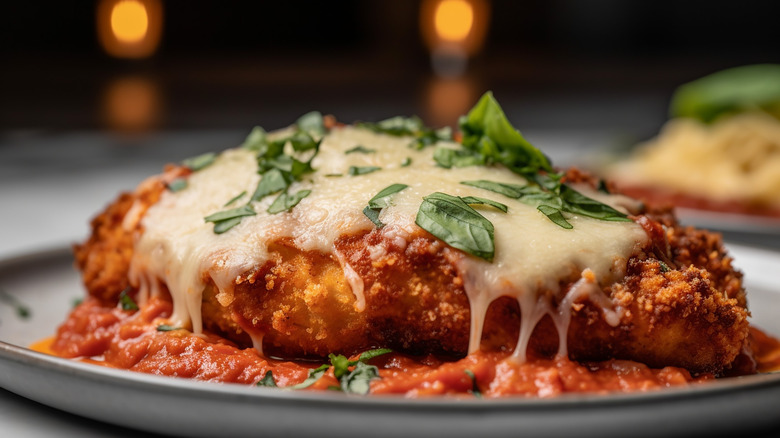Prevent Soggy Chicken Parm Breading With One Genius Tip
The crispy breadcrumbs and craggy edges of a classic chicken parmesan are the bomb. Who doesn't love that golden crunch, teamed with the herby aroma of marinara and the inviting gooiness of a mega cheese pull? However, make some rookie mistakes, such as failing to fully coat your chicken cutlets or frying them on low heat, and it can result in breading that's soggy and saturated with oil instead of shatteringly crisp. One genius way to prevent soggy chicken parm is to substitute some of your breadcrumbs with more parmesan.
Japanese panko is the perfect breadcrumb of choice for coating chicken because it absorbs less oil than other varieties, such as Italian, golden, or gluten-free options. Comprised of crust-less white bread made via electric current, panko is super-crispy and develops a rich golden color when fried. Having said that, it isn't 100% immune to becoming greasy if you cook your chicken on a low heat, much like other types of breadcrumbs made of sourdough or rye, because it contains starch, which absorbs liquids like a sponge. Switching some of the Panko for shredded parmesan reduces the amount of starch in your breading, thereby limiting its capacity to imbibe the oil in your skillet. Simply sub a handful of parm for panko or go full throttle with a higher ratio of cheese to breadcrumbs if you want an uber-crispy, salty crust.
Always shred your own parmesan
Some pre-grated varieties of cheese contain a starch called cellulose to stop the individual shreds from clumping together in the bag. However, a hunk of fresh parmesan is free from additives, like potato starch, and is made solely from cow's milk, salt, and rennet, which means it doesn't swell up and absorb liquids. In fact, when parmesan meets a hot skillet it doesn't melt into a gooey mass; rather it turns crackly because it has a lower moisture content than other cheeses like mozzarella.
Take care to grate your own parmesan straight from the wedge when making the breading for chicken parmesan, or indeed any other dish that requires a crispy coating, such as croquettes or schnitzels, to eliminate the presence of added starch. The absolute best way to grate cheese is to lay your box grater on its side so a greater surface area of the cheese comes into contact with the blades (a word of advice: Always save any leftover parmesan rinds for mac and cheese to avoid waste).
Of course, the added benefit of subbing some of the breadcrumbs in your crispy coating for parmesan is the additional boost of salty, savory flavor. Parmesan cheese naturally contains a high amount of glutamate — the amino acid responsible for giving foods an umami taste — which means it's perfect for lending an array of dishes a satisfying roundness.

